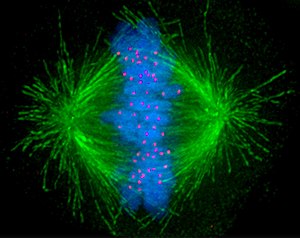
A kinetochore (/kɪˈnɛtəkɔːr/, /-ˈniːtəkɔːr/) is a disc-shaped protein structure associated with duplicated chromatids in eukaryotic cells where the spindle fibers attach during cell division to pull sister chromatids apart.[1] The kinetochore assembles on the centromere and links the chromosome to microtubule polymers from the mitotic spindle during mitosis and meiosis. The term kinetochore was first used in a footnote in a 1934 Cytology book by Lester W. Sharp[2] and commonly accepted in 1936.[3] Sharp's footnote reads: "The convenient term kinetochore (= movement place) has been suggested to the author by J. A. Moore", likely referring to John Alexander Moore who had joined Columbia University as a freshman in 1932.[4]
Monocentric organisms, including vertebrates, fungi, and most plants, have a single centromeric region on each chromosome which assembles a single, localized kinetochore. Holocentric organisms, such as nematodes and some plants, assemble a kinetochore along the entire length of a chromosome.[5]
Kinetochores start, control, and supervise the striking movements of chromosomes during cell division. During mitosis, which occurs after the amount of DNA is doubled in each chromosome (while maintaining the same number of chromosomes) in S phase, two sister chromatids are held together by a centromere. Each chromatid has its own kinetochore, which face in opposite directions and attach to opposite poles of the mitotic spindle apparatus. Following the transition from metaphase to anaphase, the sister chromatids separate from each other, and the individual kinetochores on each chromatid drive their movement to the spindle poles that will define the two new daughter cells. The kinetochore is therefore essential for the chromosome segregation that is classically associated with mitosis and meiosis.
- ^ Santaguida S, Musacchio A (September 2009). "The life and miracles of kinetochores". The EMBO Journal. 28 (17): 2511–31. doi:10.1038/emboj.2009.173. PMC 2722247. PMID 19629042.
- ^ Sharp LW (1934). Introduction to cytology (3rd ed.). New York: McGraw-Hill Book Company, inc. doi:10.5962/bhl.title.6429.
- ^ Schrader F (1936-06-01). "The kinetochore or spindle fibre locus in amphiuma tridactylum". The Biological Bulletin. 70 (3): 484–498. doi:10.2307/1537304. ISSN 0006-3185. JSTOR 1537304.
- ^ Kops GJ, Saurin AT, Meraldi P (July 2010). "Finding the middle ground: how kinetochores power chromosome congression". Cellular and Molecular Life Sciences. 67 (13): 2145–61. doi:10.1007/s00018-010-0321-y. PMC 2883098. PMID 20232224.
- ^ Albertson DG, Thomson JN (May 1993). "Segregation of holocentric chromosomes at meiosis in the nematode, Caenorhabditis elegans". Chromosome Research. 1 (1): 15–26. doi:10.1007/BF00710603. PMID 8143084. S2CID 5644126.